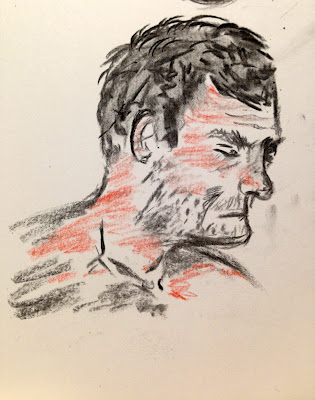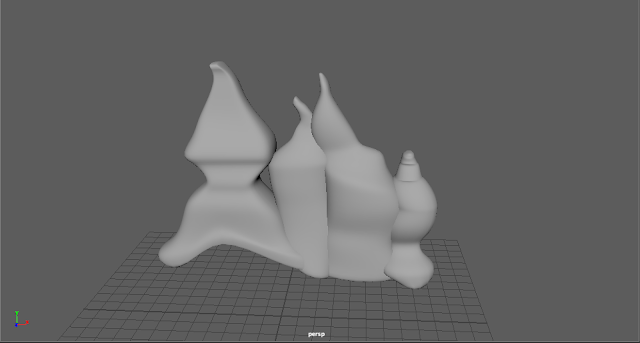Sky's creative space
Sunday, 6 December 2015
Saturday, 5 December 2015
Friday, 4 December 2015
Wednesday, 2 December 2015
Life drawing 2.12.15
Really enjoyed today's session. I experimented with charcoal and colour pastels. I am really pleased with my final 30 minute study, it came out pretty good! :)
 |
| Final 30 minute study |
 |
| First drawing far left - 15 minutes The rest were 5 minute poses each |
 |
| 5 minute poses |
 |
| 15 minute pose |
 |
| 10 minute face study |
Tuesday, 1 December 2015
Repulsion (1965) Film review
 |
| Fig. 1 Repulsion (1965) official film poster |
Repulsion (1965) directed by Roman Polanski, is a psychological thriller/horror about a woman with an inherent fear of men and intimacy. The film is set in 1960's London, England and discusses the horrors of someone with a severe mental illness. The director cleverly places the audience in a voyeuristic state, allowing us to closely witness the protagonist's world crumble and fall as she gives in to her fears and loses her sense of identity. 'The film opens, as it closes, in darkness before the camera draws back and reveals itself as the pupil of Carol's eye' (Butler, 1970) 'In other words, from the start of Repulsion, we are not sure whether we are 'inside' or 'outside' Carol's mind.' (Brown, 2013) An ambiguous quality that makes the experience all the more bizarre and interesting.
The film first introduces us to pretty, Belgian manicurist, Carol who lives with her sister, Helen in a small, shabby apartment. From the very start of the film, the audience senses that there is something odd about the protagonist, Carol. She seems to always be in a constant trance-like state and her gaze is both empty and frightening. She is also very fearful of men and avoids any form of contact with them. As the film progresses, Carol becomes more and more delusional and out of touch with reality. However, it is not until her sister embarks on a trip with married boyfriend Colin, that Carol's condition truly worsens as she begins to be 'tormented by ghoulish beasts, both real and imagined.' (Miraudo, 2010) These 'beasts' take the form of a rapist in her bed, huge, gaping cracks in the walls and big, hairy hands protruding out of walls, reaching out to grab her. It is vital to note that 'since Carol responds to these occurrences as if they were real, it becomes difficult to tell which images are symbolic and which are literal.' (Brown, 2013) 'These strange and highly disturbing hallucinations gradually drive her to the brink of madness, resulting in murder.' (Hutchinson, 2012) She commits her first murder by bludgeoning her male admirer, Colin, with a candlestick when he forcefully breaks down her front door and enters her house. After killing him, she drags his body and dumps it in the bath. Colin's death was almost inevitable as he had committed a dangerous act: 'attempting to forcefully penetrate Carol's mind/personal space.' (Brown, 2013) This is something that she cannot allow and takes severe preventative measures to avoid it from occurring, by cutting the cord off her telephone and refusing to leave her house; subsequently cutting off all ties from the terrifying world outside her door.
 |
| Fig. 2 Repulsion (1965) Carol is tormented by ghoulish beasts... |
The sound of the ticking clock serves as an indicator that something terrible is about to occur, Carol is aware of this and she waits in terrible anticipation, before turning around to see her rapist in her bed. The camera then focuses on the two of them as she struggles fearfully and is viciously assaulted. In the same way, 'the sound of the Varsouviana polka grows louder and louder in her [Blanche's] mind, the revolver shot puts a temporary end to it. She comes to wait for the sound of the shot to relieve her of the nightmare, if only temporarily.' (Sambrook, 2003) Both women experience these harrowing nightmares of the mind on a daily basis and both women learn to live with it. Before her third rape, Carol is shown applying bright, red lipstick, this could serve as an alarming and poignant indication that she is starting to become accustomed to it, and is preparing herself for the recurring nightmare. 'This practical way of dealing with a nightmare is truly terrifying, as she accommodates the terrors in her daily life.' (Sambrook, 2003)
French philosopher, Gaston Bachelard's book The Poetics of Space was around at the time when Roman Polanski made Repulsion. In this book, 'Bachelard explored a third kind of space, the 'felicitous' space of the home and its domestic menagerie of tables, chairs, cupboards and stairs.' (Worpole, 2013) He was a 'phenomenologist, holding the view that there was a dynamic interplay between an active mind and its surroundings.' (Worpole, 2013) 'Polanski too made much of this interdependence in each of his 'Apartment Trilogy' films: Repulsion (1964), Rosemary's Baby (1968) and The Tenant (1976).' (Woodham, 2013) These films all express how the nightmares in your mind can effect the space around you.
Repulsion was directed in the year 1965, an iconic decade most famously known for its popular fashion, ground-breaking music and the revolutionary introduction of the contraceptive pill. London had undergone a significant transformation, from the 'gloomy, grimy post-war capital into a bright, sining epicentre of style'. (History of London) The introduction of the mini-skirt by fashion designer Mary Quaint was a huge success amongst women of the 60's. With the rise in income, Londoners had more money than ever before and were looking for ways to spend it. 'Music was also a huge part of London's swing. While Liverpool had The Beatles, the London sound was a mix of bands who went on to worldwide success, including The Who, The Kinks, The Small Faces and of course, world famous band, The Rolling Stones.' (History of London)
Overall, it is a disturbing but interesting film. Polanski's 'depiction of a young woman's dissolution into madness is one of the most harrowing mental descents ever depicted onscreen, and it is one that you will never forget.' (Baumgarten, 1997)
Bibliography
(2013) Swinging 60's - Capital of Cool. At: http://www.history.co.uk/study-topics/history-of-london/swinging-60s-capital-of-cool (Accessed on 1.12.15)
Baumgarten, M. (1997) Repulsion . Austin Chronicle . 11-24-97. At: http://www.filmvault.com/filmvault/austin/r/repulsion1.html (Accessed on 1.12.15)
Brown, W. (2013) Supercinema: Film Philosophy for the Digital Age. (First ed.) Berghahn Books. p. 64
Hutchinson, T. ( 2012) Repulsion. At: http://www.radiotimes.com/film/mc4pz/repulsion (Accessed on 1.12.15)
Miraudo, S. (2010) Play it again - Repulsion review. At: https://www.quickflix.com.au/News/PlayItAgain/Repulsion/6997 (Accessed on 1.12.15)
Sambrook, H. (2003) York Notes Advanced - A Streetcar Named Desire. (Second ed.) London: York Press. pp. 62-63.
Woodham, N. (2013) Repulsion. At: http://www.electricsheepmagazine.co.uk/reviews/2013/01/03/repulsion/ (Accessed on 1.12.15)
Worpole, K. (2013) Book of a lifetime: The Poetics of Space, by Gaston Bachelard. At: http://www.independent.co.uk/arts-entertainment/books/reviews/book-of-a-lifetime-the-poetics-of-space-by-gaston-bachelard-1673212.html (Accessed on 1.12.15)
Illustration list
Fig. 1 Repulsion (1965) official film poster. At: https://uk.movieposter.com/poster/MPW-30800/Repulsion.html
Fig. 2 Repulsion (1965) A GIF from the film. At: https://www.tumblr.com/search/mine:%20repulsion
Subscribe to:
Comments (Atom)






